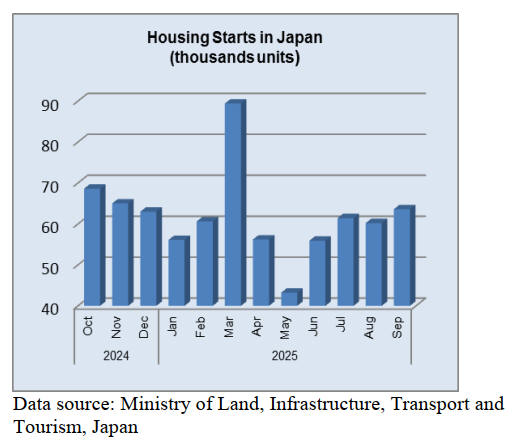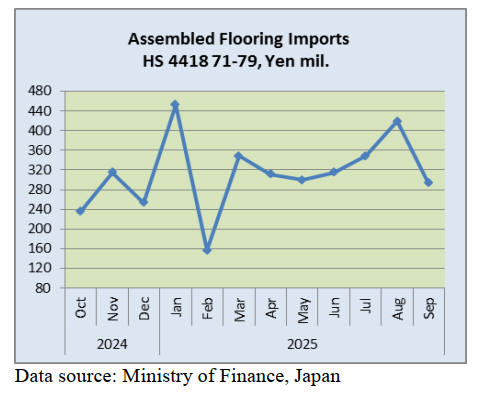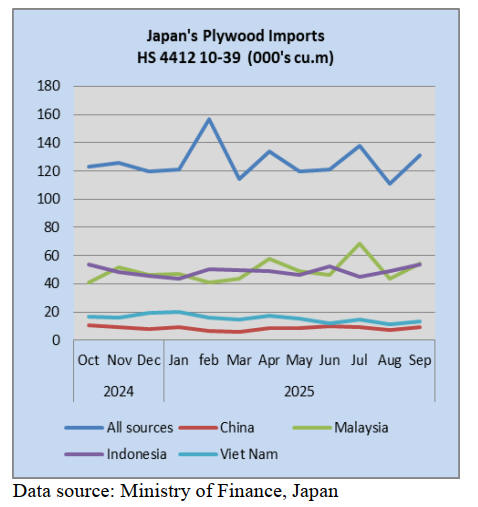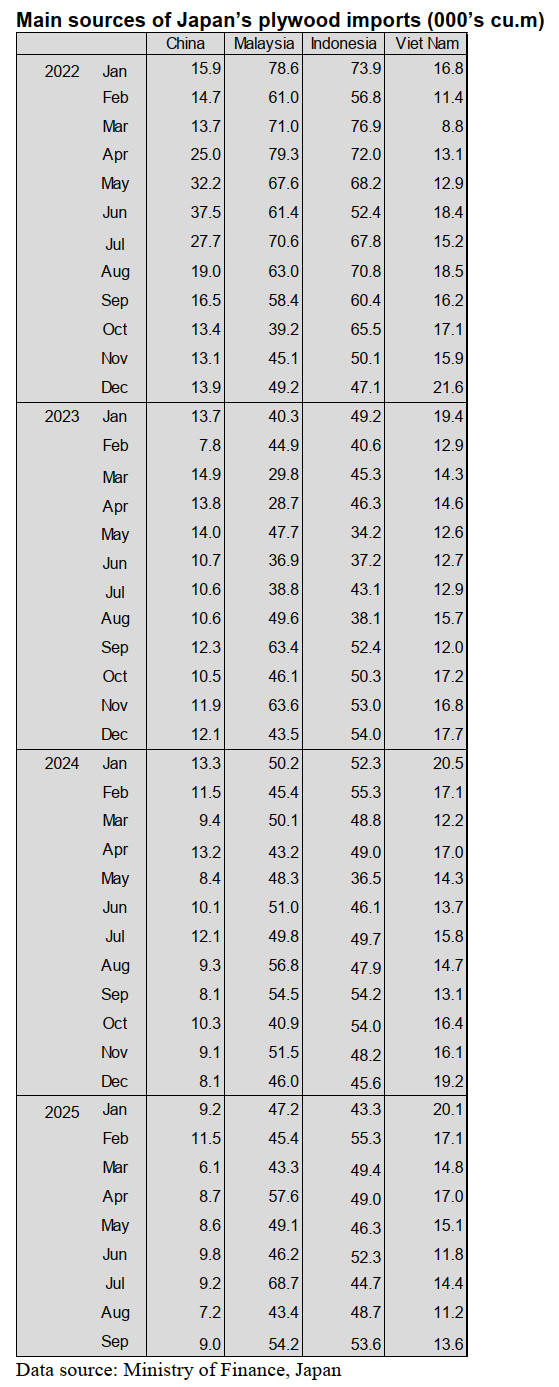Japan
Wood Products Prices
Dollar Exchange Rates of 10th
November
2025
Japan Yen 154.14
Reports From Japan
New economic package planned
The government has drafted an economic package to
support the Prime Minister’s "responsible and active fiscal
policy." The plan is expected to be adopted by the end of
November. It is reported the package will include
expanding subsidies for local governments to distribute
rice and shopping vouchers to households amid the rising
cost of living. The subsidies will also be used to help small
businesses raise wages.
The government will also raise the ceiling on long-term,
fixed-rate housing loans. Some private-sector members of
the Council on Economic and Fiscal Policy said that the
size of a supplementary budget to finance the economic
package could exceed the fiscal 2024 level of 13.9 trillion
yen.
See: https://www.nippon.com/en/news/yjj2025111300563/
Rise in Japanese manufacturer confidence
Business sentiment in Japan is mixed but showing signs of
improvement with large manufacturing firms expressing a
rise in confidence due to a strong export performance,
small and medium sized businesses are also seeing some
positive shifts. Recent data indicates large manufacturers'
sentiment is at a three-quarter high and forecasts for the
final quarter remain optimistic, although there are
headwinds as a result of sluggish domestic consumption
and concerns over US tariffs.
The Business Survey Index (BSI) for large manufacturing
firms rose to a three-quarter high in the third quarter of
2025 returning to positive territory and beating market
expectations.
The business sentiment index for medium size companies
improved in the July-September 2025 period and
surprisingly sentiment for small businesses also improved
but only to minus 9.6 in the third quarter of 2025, an
improvement from minus 12.3 in the previous quarter.
Manufacturers are projecting further improvement into the
fourth quarter of 2025 though a slight decline is expected
in the first quarter of 2026.
Japanese manufacturing confidence surged to its highest
level in nearly four years in November, led by the
electronics and auto sectors which have been buoyed by
softness in the yen and solid orders according to the
Reuters Tankan survey. In other news, Japanese listed
companies saw April-September net profits rise 7% year
on year, a record high despite US tariffs.
See:
https://www.japantimes.co.jp/business/2025/09/11/economy/japa
n-big-firm-sentiment/
Inflation above Bank of Japan target
Headline inflation and core inflation, which excludes fresh
food, are firmly above the central bank’s 2% target which
is complicating the Banks options for additional interest
rate increases.
The issue is that the durability of inflation remains
questionable. Headline inflation is moving due to factors
unrelated to domestic demand. For example, energy and
government subsidies for education were the main
contributors to the recent drop in headline inflation. At the
same time, food prices are pushing inflation in the other
direction. Food items are currently the principal drivers of
current inflation.
See:
https://www.deloitte.com/us/en/insights/topics/economy/asia-
pacific/japan-economic-outlook.html

Weak yen - direct intervention may not deliver this time
The yen fell to a new low in mid-November reaching a
level when, in the past, the government intervened in the
currency market. This time currency traders are not
optimistic that the new government will be able to shore
up the yen by direct intervention.
Analysts point out that, unlike last year when intervention
took place in the run-up to higher interest rates by the
Bank of Japan, this time Japan would be buying yen just
as Prime Minister Sanae Takaichi signals her desire for a
slowdown in rate hikes.
The yen has fallen about 4.5% against the dollar so far this
quarterand was trading at 154 to the US dollar in mid-
November
See:
https://www.japantimes.co.jp/business/2025/11/13/economy/yen-
dollar-intervention-debate/

Families priced out of Tokyo's real estate market
The Japanese capital is taking action to provide lower-cost
housing for the growing number of families that have been
priced out of Tokyo's skyrocketing real estate market.
Starting in fiscal 2026, public-private funds totalling more
than 20 billion yen (US$130 million) will provide housing
with rents around 20% below market rates.
Tokyo is launching an affordable housing initiative to
begin in April 2026 using a combination of public and
private funds to provide family-sized units at rents about
20% below market rates. This programme comes as rental
prices have soared and the supply of new condominiums
has hit a 30-year low.
The Tokyo Metropolitan Government will invest 10
billion yen, with the private sector raising more than 10
billion yen and the funds will be used for both new and
existing properties.
See: https://asia.nikkei.com/business/markets/property/tokyo-to-
roll-out-affordable-housing-for-families-as-rents-soar

Positive growth forecast for construction market
Mordor Intelligence has published a new report on the
Japan Construction Market offering an analysis of trends,
growth drivers and future projections.
The Japan construction market size is forecast to be
around US$528 billion in 2025 and is likely to reach
US$621 billion by 2030, translating into a 3.3% CAGR,
says the report. This growth is driven by steady demand in
residential, commercial and infrastructure projects.
Analysts note that the Japan construction sector is
increasingly influenced by both domestic and international
players who contribute to the modernisation of urban
spaces and the expansion of transport and industrial
facilities.
See: https://www.openpr.com/news/4252818/japan-construction-
market-forecast-to-reach-621-83-bn-by-2030
Import update
Assembled wooden flooring imports
After 3 months of steady increases in the value of imports
of assembled wooden flooring (HS44187179) there was a
sharp correction in September as the value of imports
dropped 30% from August. Year on year the value of
September 2025 imports was at around the same level as
in September 2024.
Of the various categories of assembled flooring imports
report 71% was of HS 441875 with China and Vietnam
being the top shippers. For the other categories HS441879
accounted for 13% of September imports followed by
HS441873 (11%) and HS441874 (5%).
Of HS441873 imports all originated in China and shippers
in China accounted for over 60% of HS441874 arrivals in
September with the others suppliers being Viet Nam,
Indonesia and Thailand.


Plywood imports
As in previous months Indonesia and Malaysia were the
top suppliers of plywood to Japan in September and the
combined volume of shipments accounted for over 80% of
Japan’s plywood imports, the other top shippers being Viet
Nam and China. September 2025 import volumes were
18% higher than in August 2024 but came in at around the
same level as in September 2024.
The volume of September 2025 imports from Malaysia
and Indonesia rose as they did from the other main
shippers, Vietnam and China.
In September 2025 arrivals of HS441210-39 were reported
at 131,017 cu.m (110,998 cu.m in August). As in previous
months of the various categories of plywood imported in
September HS441231 accounted for most followed by
HS441233 and HS441234 with the balance being
HS441239.


Trade news from the Japan Lumber Reports (JLR)
The Japan Lumber Reports (JLR), a subscription trade
journal published every two weeks in English, is
generously allowing the ITTO Tropical Timber Market
Report to reproduce news on the Japanese market
precisely as it appears in the JLR. For the JLR report
please see: https://jfpj.jp/japan_lumber_reports/
First 2x4 lumber exports to the U.S.
Sumitomo Forestry Co., Ltd. announced that it had
exported Japanese cedar 2x4 lumber to the United States,
where the shipment was graded by a local inspection
agency. The export volume was equivalent to one
container load, totaling 45 cbms.
Nearly the entire shipment met local standards and was
stamped with the appropriate grade mark. While Japanese
cedar fence materials have previously been exported to the
United States, this marks the first time that 2x4 structural
lumber has been shipped to the country, adding a new
chapter to the history of Japan’s timber industry.
As part of efforts to expand demand for wood products,
Sumitomo Forestry has been working closely with its
partner companies to promote the export of domestically
produced structural lumber, recognizing its importance in
this context. The company loaded 2x4 lumber produced at
the Chugoku Mokuzai Noshiro Plant into a container and
exported it from Akita Port to Seattle in early August.
The shipment consisted of roughly equal portions of JAS-
certified and non-JAS lumber. Sumitomo Forestry
requested grading from Fritch Mill, a member company of
a grading agency based in Washington State. On
September 25, nearly the entire volume was found to meet
local standards and was stamped with the appropriate
grade mark.
Sumitomo Forestry views this as a first step toward
exporting structural lumber to the United States. However,
several challenges remain, including the compatibility of
Japanese cedar structural lumber with the U.S. market, the
added costs associated with import tariffs, and supply
issues, particularly the difficulty of securing logs in Japan
that meet the length requirements for 2x4 lumber
production.
However, the company plans to promote Japanese cedar
lumber in the U.S. market by leveraging its expertise in
architecture-related fields to explore prototype
applications using the imported 2x4 structural lumber.
Through these efforts, it aims to expand demand for
domestically produced wood products within the United
States.
Monthly volume falls below 100,000 m³ for first time in
2025
In August, Japan’s log exports to China fell below 100,000
cubic meters for the first time in 2025. The August total
was 85,227 cbms, marking the first time monthly volume
has fallen below 100,000 cubic meters since January 2024.
The impact of the Trump tariffs had already begun to
surface in the first half of the year, but with the added
slowdown in China’s domestic economy in the second
half, the downward trend has become more pronounced.
At the end of September, U.S. President Donald Trump
signed a proclamation to impose phased tariffs of 10% to
50% on imports of lumber and processed wood products
bound for the United States, effective from October 14,
2025 through January 1, 2026 of the following year.
Since spring, demand for Japanese cedar logs has declined
among local manufacturers in China who produce cedar
fencing and decking materials for export to the United
States, due to the impact of the Trump tariffs. In the
second half of the year, demand also stagnated among
local manufacturers shipping cedar lumber for
construction and civil engineering use within China, due to
the slowdown in the Chinese economy.
The export price of Japanese cedar logs stood at just over
USD 100 per cbm (C&F), down roughly 10% from the
beginning of the year, with a continued weakening trend.
From January to August 2025, total log exports reached
1.162 million cbms, representing a 90% increase
compared to the same period last year and maintaining a
high overall level. However, with roughly 90% of this
volume bound for China, the recent slowdown in Chinese
demand is having a significant impact on the overall
market.
Total log exports in August also fell below the 100,000
cbms mark, coming in at 99,235 cbms. If this pace
continues, the final export volume for 2025 may fall short
of the 1.819 million cbms recorded in 2024.
South Sea logs and lumber
Domestic distribution of hardwood products continues to
show signs of stagnation. Among imported products,
production and shipments of South Sea timber items such
as Merkus pine laminated free boards and decking
materials appear to be delayed due to adverse weather
conditions in Indonesia.
Prices of Indonesian products are rising or showing signs
of an upward trend, primarily due to reduced log supply
caused by adverse weather conditions. While the impact
on the domestic market remains limited, some distributors
have begun actively procuring due to inventory shortages.
The supply-demand balance for South Sea hardwood logs
remains stable.
Although log consumption by domestic South Sea timber
manufacturers has slowed compared to the same period
last year due to deteriorating market sentiment, they
continue to secure supply as usual for bulk shipments,
which are said to occur two to three times a year.
Trilateral plywood conference
The Trilateral Plywood Conference, bringing together
plywood-related organizations from Indonesia, Malaysia,
and Japan, was held on September 18 in Miri, Sarawak,
Malaysia, where participants exchanged views on the
current situation in their respective countries.
No urgent issues emerged regarding log supply or
domestic and international plywood conditions, resulting
in a calm and steady conference throughout. The next
meeting is scheduled to be held in Indonesia. Participants
included the Indonesian Plywood Association from
Indonesia; the Sarawak Timber Association and the Sabah
Timber Industries Association from Malaysia; and the
Japan Plywood Manufacturers' Association and the Japan
Lumber Importers' Association from Japan, with a total of
30 attendees.
The conference began with presentations on the economic
conditions and plywood-related circumstances in each
country, followed by an open discussion. The Japanese
delegation reported on the state of the domestic market,
with representatives assigned to specific sectors such as
flooring base panels, thin plywood and general-purpose
panels (GP), and formwork.
The Indonesian delegation reported that five companies
are expected to face anti-dumping duties of up to 300% in
the U.S., and that no resolution is currently in sight. The
Malaysian delegation raised a question regarding the
increasing exports of Japanese sugi logs.
|